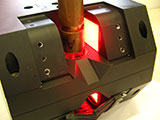Optical sensor increases spot welding efficiency in the automotive industry
Fraunhofer IPMS will present the prototype of an optical sensor system at the 2014 SmartSystemsIntegration
Three research institutes and four industrial companies worked for two years within the framework of the »SmartDress« European joint research project on the development of a fully automated system for the monitoring, optimization and post processing of electrode tips for resistance spot welding in the automotive industry. Hereby, Fraunhofer Institute for Photonic Microsystems IPMS in Dresden provided the optical measuring system with which the wear on the welding electrodes can be measured rapidly and precisely. This knowledge helps to preserve the quality of welded joints, increase the life cycle of electrode tips and thereby make it possible to use spot welding economically even for sophisticated materials such as aluminum. Fraunhofer IPMS will present a prototype to a wide specialist public at the 2014 SmartSystemsIntegration in Vienna from 26th to 27th March 2014.
Nowadays, an average family car is held together by approx. 5,000 spot welds. For many years, the welding process used for this purpose, resistance spot welding, has been the undisputed top technique for the long term joining of steel plate in the automotive industry, in bodywork and vehicle construction and in the sheet steel processing industries in general. This process is economical, efficient and robust and the definitive welding parameters such as the type, thickness, number of components to be welded, their compatibility and surface finish and the cooling of the welding electrode can be efficiently controlled and planned. However, to date one essential quality characteristic has not been systematically recorded – the wear on the welding electrode. An increasing number of welding processes leads to the electrodes wearing out and consequently the cross section of the contact areas increases in size due to thermal and mechanical influences. This leads to the spot weld becoming ever larger and the melting area between the plates becoming irregular to the extent that they no longer bond. This is prevented by regularly dressing or reworking the electrode tips in order to maintain their original cross section. In case of galvanized steel, the wear is moderate and can be corrected on the basis of past experience. However the welding of aluminum components leads to such excessive wear that most body manufacturers consider aluminum spot welding to be totally unsuitable. For some assemblies the electrodes are already worn out before one part has been completed. To date the intervals between the reworking of electrode tips are usually determined according to experience. This practice results in: avoidable production line down times during the maintenance intervals, unnecessary consumption of the copper electrodes and time and material intensive optimizing of the maintenance intervals during the set-up phase for new production lines.
It is not necessary to put up with these disadvantages, thought the designers at the Fraunhofer Institute for Photonic Microsystems IPMS in Dresden. Fraunhofer IPMS collaborated with two additional research institutes and four industrial companies within the framework of the European joint research project, »SmartDress« [EU PR: 286598], to design a fully automated system to regulate the maintenance of electrode tips for resistance spot welding. At the core of the system is an optical sensor which records the condition of the welding electrode and thereby calculates the time and extent of cleaning or mechanical post processing required. Michael Leuckefeld, project manager at Fraunhofer IPMS, explains the operation as follows: »Our system monitors both welding electrodes simultaneously from various perspectives. We use diffuse monochrome LED lighting generated by opal glass for this purpose. The light is sent to the electrode via a mirror arrangement and beam splitter and then back to the photo detector. Lighting and image recording thus use the same optical elements«. The first prototype is based on a passive camera system which is controlled by an external computer via a USB interface. Later, the control is to be integrated into the sensor system. The first tests under live production conditions are scheduled to take place during the current year.
The SmartDress project was recently concluded with a series of successful tests. A prototype of the Fraunhofer IPMSs optical »SmartSystem« will be presented to the specialist public at its exhibition stand number A-02 at the SmartSystemsIntegration trade fair in Vienna from 26th to 27th March 2014.
About SmartDress
SmartDress is an EC funded project under Framework 7, research for SME's. Within the project a fully adaptive system for spot welding electrode maintenance has been created. The SmartDress system represents a significant step forward in electrode tip dressing technology, offering a functionality and performance beyond the scope of any system presently on the market.
The SmartDress project team consists of four SME's; Sinterleghe srl. a leading producer of electrode tip dressing equipment, Fisher-Smith a provider of specialised visual system solutions, Finaids a provider of high spec industrial abrasives and Swantec a world leader in modelling software for welding processes. Technical developments are driven by three research organisations; TWI responsible for the technical performance of the resistance spot welding process, Fraunhofer IPMS responsible for the development of the optical sensor, VTT responsible for providing an abrasive dressing solution.
 Fraunhofer Institute for Photonic Microsystems
Fraunhofer Institute for Photonic Microsystems